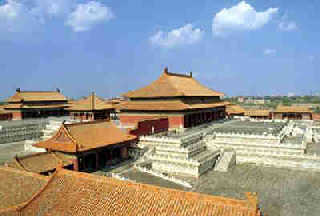|
The Palace Museum
 The Palace Museum is situated at the center of Beijing's meridian line to the north of Tian'an men Gate. Also known as the Forbidden City, it was the imperial palace of the Ming and Qing dynasties. The Palace Museum is situated at the center of Beijing's meridian line to the north of Tian'an men Gate. Also known as the Forbidden City, it was the imperial palace of the Ming and Qing dynasties.
The Palace Museum contains the world's largest group of intact palace structures make largely of timber. It was listed as a world cultural heritage site in 1987. Construction of the palace began in 1406, the fourth year of the reign of Ming Emperor Yongle, and it was completed 14 years later. In the years that followed, 24 emperors have ascended the throne and the last emperor, Pu Yi, was driven from the palace in 1924. The year after the palace was converted into a museum and opened to the public.
Covering a rectangular area of 720,000 square meters the museum stretches 960 meters from north to south and 750 meters from east to west. There are 9,999 and a half, towers, buildings and pavilions and a total combined floor space of 150,000 square meters. The dark red outer wall is 3,400 meters long and at the corners there are four corner towers. Around the palace there is a city moat.
The structures in the palace were all built on the meridian line and there is an Inner Palace and an Outer Palace. The main buildings in the Outer Palace are three halls the Hall of Supreme Harmony, the Hall of Complete Harmony and the Hall of Preserving Harmony. All of them were built on an eight-meter-high platform and they occupy a total area of 85,000 square meters. The Hall of Supreme Harmony is the largest of three, with a floor space of 2,377 square meters. It is 35 meters high, 63 meters long and 33.33 meters wide. The hall is the largest timber structure in the country.
At the center there is a golden lacquer ware throne set between two golden pill ars both decorated with dragons and it was the symbol of feudal and imperial power. Enthroning ceremonies, birthday parties, festival celebrations, ceremonies for sending forces on punitive expeditions and other important activities were held in the hall. To the north is the hall of Complete Harmony where the emperor rested before attending important ceremonies and met people who came to pay their respects there. The Hall of Preserving Harmony at the northern end was the place where banquets were held and candidates sat the final imperial examinations. ars both decorated with dragons and it was the symbol of feudal and imperial power. Enthroning ceremonies, birthday parties, festival celebrations, ceremonies for sending forces on punitive expeditions and other important activities were held in the hall. To the north is the hall of Complete Harmony where the emperor rested before attending important ceremonies and met people who came to pay their respects there. The Hall of Preserving Harmony at the northern end was the place where banquets were held and candidates sat the final imperial examinations.
North of the Hall of Preserving Harmony is the Inner Palace where the emperor carried out his daily work and the empress, concubines, princes and princesses lived, played and paid their respects to God. The main buildings in the Inner Palace include the Palace of Heavenly Purity, the Hall of Union and Peace and the Palace of Earthly Tranquility. There are 12 palace courtyards on either side. There are also three gardens Longevity Garden, Kindness and Tranquility Garden and the Imperial Garden. They were the playgrounds of the imperial family.
Included in the UNESCO world cultural heritage list in 1987.
Source: http://old.cnta.gov.cn
|